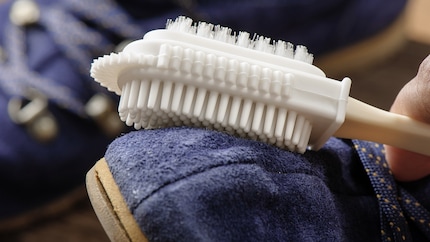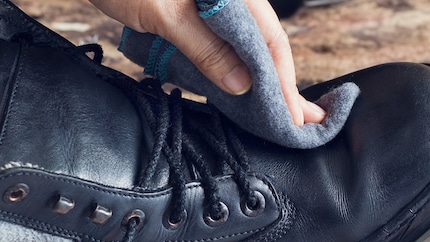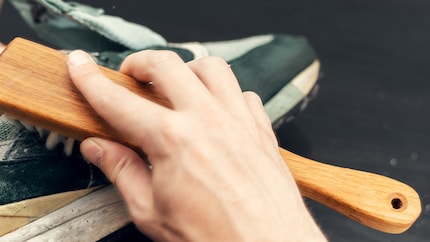
Guide
In five steps from pfui to hui: Bike shoe cleaning with Motorex
by Patrick Bardelli

Along with snow and mud, your shoes also encounter salt over the winter months. Snow, salt and mud are a bad combination, but a few straightforward tips can help both before and afterwards.
The crunch of fresh snow underfoot is one of the best things about winter. But the joy is short-lived. The snow soon turns to grey, salty slush that ruins your shoes. Well, almost. If you don’t take care of it straight away, the white residue is a nightmare to get rid of. The longer you wait, the worse it gets, as road salt dehydrates leather like table salt dehydrates the body. This leads to long-term damage. Shoes’ susceptibility to salt residue depends on how well they’ve been protected against moisture.
Whether or not you have to break in (in German) your shoes first, the right waterproofing is essential, and you need to repeat the process every few weeks. Like our skin, leather needs regular care. And while you’re doing that, treat your shoes with a cream or wax too. They take effect on the surface and protect the leather from dirt and moisture.
After wearing them in the snow, the best thing to do is rinse off your shoes with water – but not get them soaked – to prevent salt residue in the first place. If it’s already too late, the following material-specific tips will help.
Use a dry microfibre cloth to wipe off as much salt residue as possible. Go over the edges with a suede brush or toothbrush with soft bristles. Work as gently as possible to prevent damaging the structure of the suede. Use only as much pressure as you need to remove the remaining salt.

If that doesn’t work or your shoes are still wet, leather soap helps. Dab the salt residue with a damp, white cotton cloth to prevent any staining. Work at the marks from the outside in and keep dabbing. Otherwise you’ll ruin the structure of the suede. As soon as your shoe is completely dry, rub it again, this time all over with a suede brush or toothbrush. This re-roughens the structure.
Again, you first need to wipe off the salt residue. This time with a damp cloth. If the white marks don’t come off, use a little milk. Use a cotton cloth and work in circular movements. As soon as the salt residue has gone, rub the shoe with a dry cloth and wait until it’s completely dry. To protect against future salt residue, add a cream or wax.

Synthetic materials need relatively little maintenance. In most cases, a damp cloth is enough to wipe away any salt residue. Again, it’s worth treating the shoe with a care product afterwards.
Going over marks with a textile brush should be enough for mesh, canvas or high-tech materials you find on trainers. If that doesn’t work, grab a damp cloth that you’ve already dipped in soapy water and gently rub the mark away. Make sure you don’t get the material too wet or you’ll cause water marks. You can prevent marks by pressing a dry cloth on the areas you’ve cleaned and soaking up any excess water.

Whatever type of leather you’re dealing with, make sure you don't leave wet shoes to dry near a radiator or use a hair dryer on them. Harsh heat can make leather brittle. Instead, place newspaper inside them and let them dry at room temperature, replacing it if it becomes damp.
Teaser image: Mike_shots/Shutterstock (salt residue)/ Sergey 18/Shutterstock (snow)
When I’m not exploring the depths of the sea as an open water diver, I enjoy plunging into the world of fashion. On the streets of Paris, Milan and New York is where I keep my eyes peeled for the latest trends. And I’ll show you how to take them from the catwalk to your everyday life.
Practical solutions for everyday problems with technology, household hacks and much more.
Show all